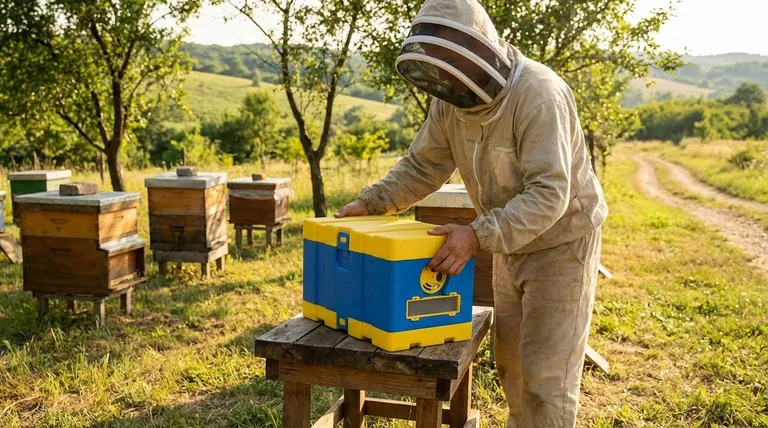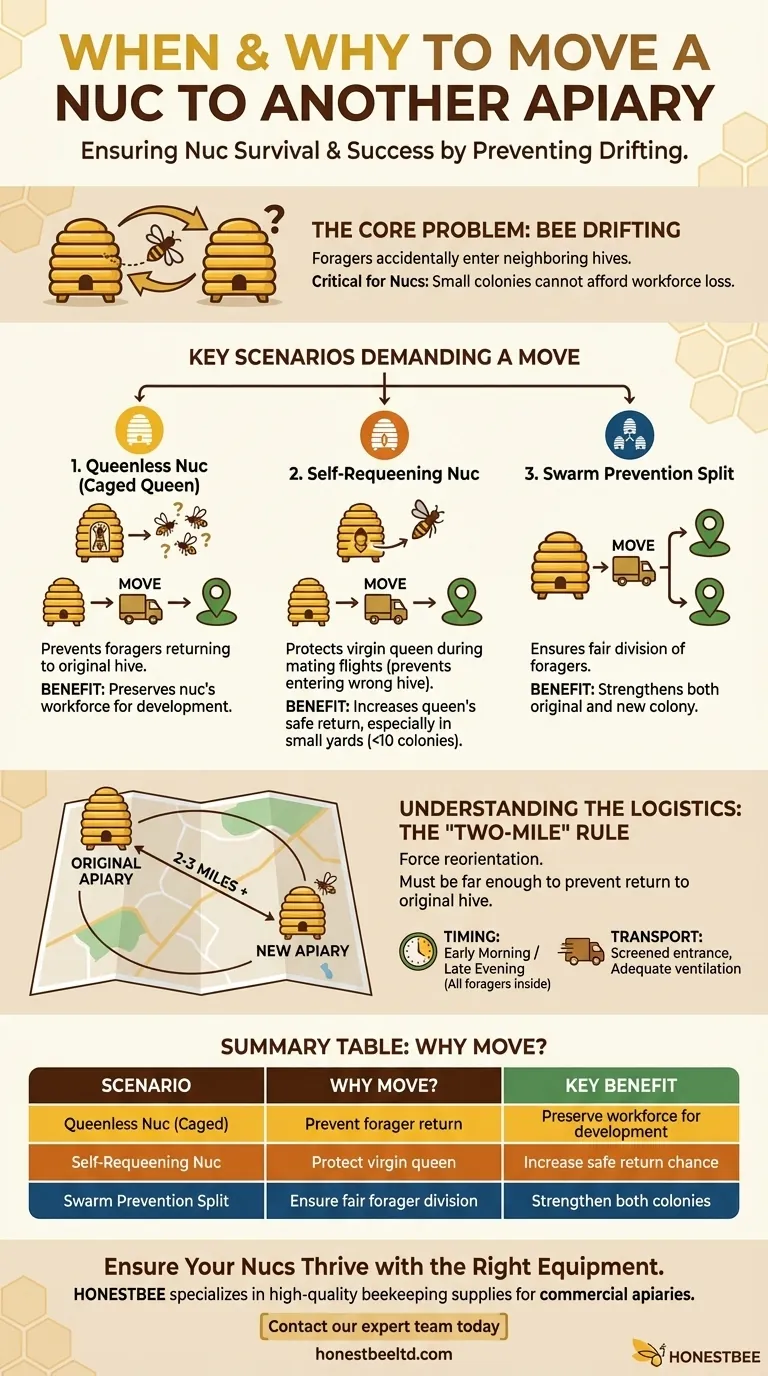You should move a nucleus colony (nuc) to a different apiary primarily to prevent the loss of its workforce due to a behavior known as "drifting." This is most critical when the nuc is made queenless and given a new queen, or when it's raising its own queen in a small yard. Moving the nuc forces the bees to reorient to their new home, ensuring the small colony retains its population and has the best chance of survival.
The core reason for moving a nuc is to combat the natural tendency of bees to return to their original hive location. By relocating the nuc at least two miles away, you break this orientation, preserving the nuc's population and protecting a new queen during her vulnerable mating flights.

The Core Problem: Bee Drifting
What is Drifting?
Drifting is the term for when foraging bees return from the field and accidentally enter a neighboring hive instead of their own. This is common in apiaries where hives are arranged in straight lines and look identical.
For a large, established colony, losing a few foragers or gaining a few from a neighbor is insignificant.
Why Nucs are Uniquely Vulnerable
A nuc is a small, developing colony with a limited population. It cannot afford to lose its foragers.
Losing even a small percentage of its workforce can set the nuc back weeks in its development, or even cause it to fail entirely. The colony needs every bee to care for brood, draw out comb, and manage the new queen.
Key Scenarios Demanding a Move
Scenario 1: The Queenless Nuc with a Caged Queen
This is the most common reason to move a nuc. When you create a nuc, you typically pull frames of brood and bees from one or more strong "donor" colonies in the same apiary.
The older bees on these frames are experienced foragers who are already oriented to their original hive. If you leave the new nuc in the same apiary, these foragers will fly out and return directly to their old home, abandoning the nuc.
By moving the nuc to a new apiary, you force every bee in it to perform new orientation flights, locking them into their new home and preserving the nuc's population.
Scenario 2: The Self-Requeening Nuc
If you create a nuc and allow it to raise its own queen from a queen cell, a different risk emerges, especially in a small apiary.
The new virgin queen must leave the hive for one or more mating flights. Upon returning, there is a significant risk she could drift into the wrong colony. If she enters a neighboring hive, she will be promptly killed.
Moving the nuc to an isolated location ensures that when she returns from her mating flight, her own nuc is the only hive she sees, dramatically increasing her chances of a safe return. The guideline to move nucs from apiaries with fewer than ten colonies exists because the risk of a queen drifting into the wrong hive is statistically higher when there are only a few other colonies nearby.
Understanding the Logistics
The "Two-Mile" Rule
To effectively force the bees to reorient, the nuc must be moved far enough away that they cannot find their way back to the original apiary.
The standard best practice in beekeeping is a move of at least two to three miles. Any less, and a significant number of foragers may still navigate back to their old location.
Timing the Move
The best time to move any colony is in the very early morning or late evening when all the foragers are inside the hive.
Ensure the entrance is screened or closed off for transport and that the hive has adequate ventilation to prevent overheating.
Making the Right Choice for Your Nuc
Moving a colony is extra work, but it is often the single most important factor in the success of a new nuc. Evaluating your specific goal will clarify the right course of action.
- If your primary focus is creating a nuc with a new, caged queen: You should almost always move it to a new apiary to prevent its foragers from abandoning the colony.
- If your primary focus is allowing a nuc to raise its own queen: Move it to another yard, especially if your primary apiary is small, to ensure the virgin queen returns home safely after mating.
- If your primary focus is preventing swarming by splitting a strong colony: Moving the split is the best practice to ensure a fair division of the foraging force between the two new colonies.
Ultimately, taking the extra step to move your nuc is a powerful investment in its future strength and survival.
Summary Table:
| Scenario | Why Move the Nuc? | Key Benefit |
|---|---|---|
| Queenless Nuc with Caged Queen | Prevents foragers from returning to their original hive. | Preserves the nuc's workforce for development. |
| Self-Requeening Nuc | Protects the virgin queen during mating flights. | Increases the new queen's chance of a safe return. |
| Swarm Prevention Split | Ensures a fair division of foragers between colonies. | Strengthens both the original hive and the new nuc. |
Ensure your nucs thrive with the right equipment.
Moving a nucleus colony is a critical step for success, and having durable, reliable supplies is just as important. HONESTBEE specializes in providing high-quality beekeeping supplies and equipment for commercial apiaries and distributors through our wholesale-focused operations.
Let us help you build stronger colonies. Contact our expert team today to discuss your apiary's needs and discover how our products can support your beekeeping success.
Visual Guide

Related Products
- 4 Frame Plastic Nuc Boxes for Beekeeping Bee Nuc Box
- HONESTBEE Professional Long Handled Hive Tool with Precision Cutting Blade
- Multi-Function Plier-Style Frame Grip Hive Tool
- Professional Multi-Function Stainless Steel Hive Tool
- Modern Flat-Mount Hive Number Set for Beekeeping
People Also Ask
- What is the recommended time of year to move bee nucs to a 10-frame hive? A Guide for Apiary Success
- How does installing a nuc differ from installing a bee package? A Guide to Starting Your Hive Right
- What are the benefits of maintaining a nuc in beekeeping? Gain Control and Resilience for Your Apiary
- What are the advantages of choosing a nucleus hive over a package of bees? Get a Head Start with a Pre-Established Colony
- What are some uses for a nucleus in beekeeping? A Guide to Apiary Growth and Resilience



















